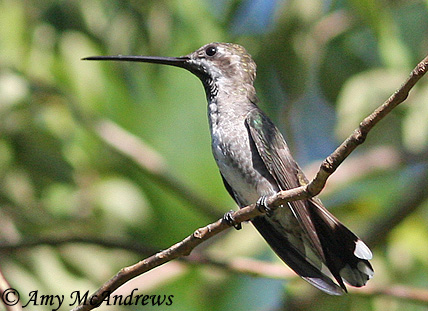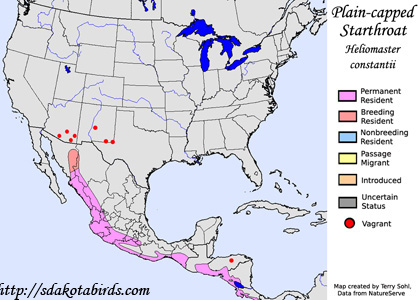| Length: 5 inches | Wingspan: 7 inches | Seasonality: Non-resident in South Dakota |
| ID Keys: Very long bill, large size for hummingbird, plain overall plumage, bold facial stripe, male has red gorget | ||
 The
Plain-capped Starthroat is a large hummingbird of Mexico and Central America
that occasionally reaches the U.S. in southern New Mexico and Arizona.
Despite the flashy name, overall the bird generally appears relatively dull
in plumage. The namesake "starthroat, a bright red gorget on the male,
only flashes its brilliant colors when the light is at the correct viewing
angle.
The
Plain-capped Starthroat is a large hummingbird of Mexico and Central America
that occasionally reaches the U.S. in southern New Mexico and Arizona.
Despite the flashy name, overall the bird generally appears relatively dull
in plumage. The namesake "starthroat, a bright red gorget on the male,
only flashes its brilliant colors when the light is at the correct viewing
angle.
Habitat: In their normal range in western Mexico and Central America, they typically inhabitant dry lowland forests, and surrounding habitat. When strays have been seen in the U.S., they have typically been found in southern Arizona canyons, near streams.
Diet: Typical diet of hummingbirds, primarily nectar, but insects also comprise a portion of the diet. Young are especially fed many insects while still dependent on the female.
Behavior: Aggressively defends feeding territory from intruders.
Nesting: Nest is typical of many hummingbird species, with plant fibers and plant down woven together with spider webs, and decorated on the outside with bits of lichen. The female is solely responsible for building the nest, incubating the eggs, and raising the young.
Song: The song is a series of crisp "chip" notes, with an occasional two-syllable chip.
Migration: Birds in the far northern part of their range are likely migratory. Birds in most of the range though are likely permanent residents, although local movements may occur in response to foraging opportunities.
Interactive eBird Map: Click here to access an interactive eBird map of Plain-capped Starthroat sightings
Feeders: Will attend hummingbird feeders
Similar Species: Female is similar to Magnificent Hummingbird.
Conservation Status: No conservation concerns are presently noted for the species.
Further Information: 1) Cornell's Neotropical Birds - Plain-capped Starthroat
2) Arizona Bird Committee - Plain-capped Starthroat
Image Information: Oaxaca, Mexico - Amy McAndrews - Photo licensed through Creative Commons 2.0 generic license.
Additional Photos: Additional Photos Coming Soon!!
| Click below for a higher-resolution map |
 |
| South Dakota Status: Non-resident in South Dakota |
Additional Lucifer Hummingbird Photos (coming soon!!)
